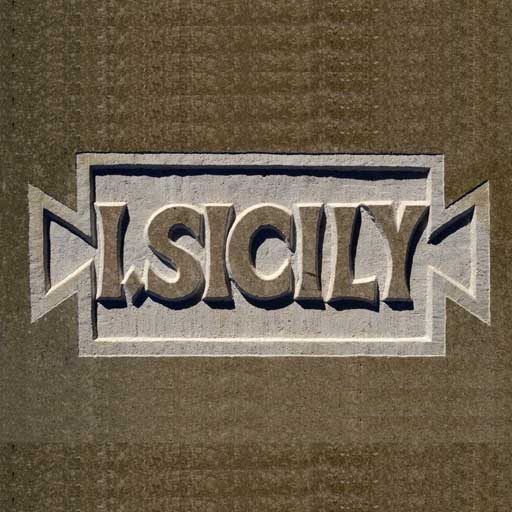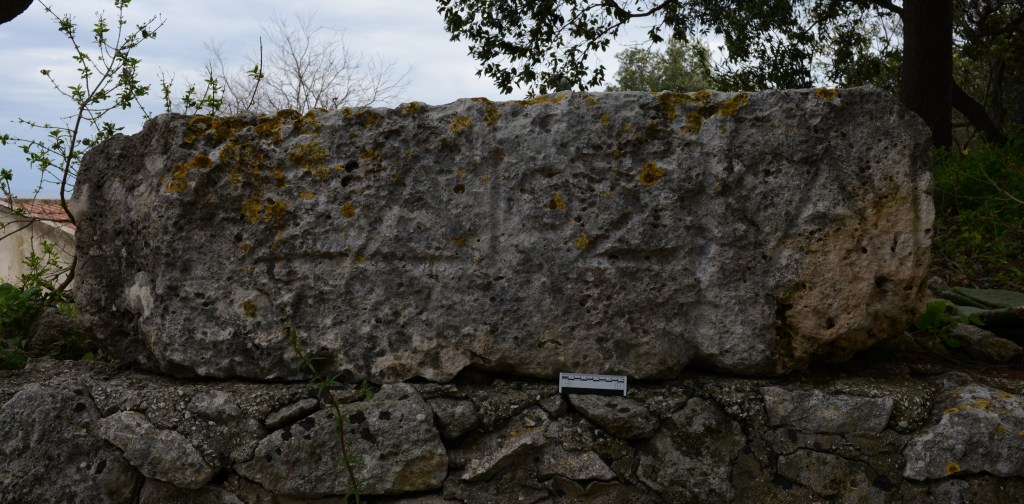
Going to the loo on an ancient site can be an interesting experience – for all sorts of reasons. At the monumental Hellenistic fortress of Euryalus on the limestone heights of Epipolai above Syracuse (handy page on the site), the short path from the ticket office to the toilets takes you past something rather special – and, inevitably, unlabelled and so probably unnoticed by almost all that pass. (Location is marked here on a map)

A large block of limestone (local, of the type used for most of the construction of the fortress), 1.43m by 0.44m by 0.63m; the left end of the face is slightly damaged, the right end intact, but the block is essentially complete. Across the face, in letters 17.5-20cm high (except omicron at 10.5cm) is the following text:
[- – -]ΥΣΔΙΟΣΚΑΙ[- – -] which suggests [- – -]υς Διὸς καὶ[- – -]
The letters ΥΣ pose something of a challenge. The rest of the text says ‘…of Zeus and…’. A second divinity’s name in the genitive is therefore likely to follow, but it’s not clear what could precede – the main options with the –υς ending are: (1) another genitive singular (many third declension words ending in –ης have a genitive in –ους), in which case a name or an object are possible, but epithets of Zeus usually follow the name, and one would expect another connective between proper names; (2) a nominative singular in -υς, or (3) an accusative plural in –ους (in the latter two cases, this would then refer to something of Zeus and …). Epigraphically, the combination only occurs (based on a search of the PHI database) as … ἱερεὺς Διὸς καὶ … (…priest of Zeus and…), but that is normally in a funerary or honorific context, describing an individual’s career, and that seems less readily applicable in such a monumental text. But we cannot go much further.
The letters are very similar to those of the inscriptions around the diazoma of the theatre built by Hieron II in Syracuse and which were inscribed after 238 BC, and consist of the names of members of the royal house and divinities (including Διὸς Ὀλυμπίου – Zeus Olympios)


Gentili, who published the text, reckoned our inscription belonged to the reign of Agathocles, but such precision is impossible. However, we could confidently say that the letter forms belong to the third century, and so might reflect work on the fortress by either Agathocles (tyrant / king 317-289 BC) or Hieron II (king c.270-215 BC). The phases of the fortress itself, which was originally constructed by Dionysios I (tyrant 405 BC – 367 BC) are very hard to determine, although a number are usually attributed to both Agathocles and Hieron II (see e.g. Winter, F. E. “The Chronology of the Euryalos Fortress at Syracuse,” American Journal of Archaeology 67 (1963) pp.363–87); sadly the inscription isn’t really going to help. What is more, although it is now located by the entrance to the fortress, this doesn’t seem to be where it originally came from, which is rather less clear (from the area of the city gate according to Gentili).
This is the only inscription visible on the site of the fortress, although it is not in fact the only inscription from the fortress: there are fragments from several monumental Greek inscriptions in the stores of the Museum in Syracuse, found at various points in the last 120 years (not all of them published, but all of them too fragmentary to tell us very much). This text is in fact published, in an article by G. Gentili in 1961 (Gentili, G. V. 1961. Nuovi elementi di epigrafia siracusana. Archivio Storico Siracusano 7: 5-25), but as far as I can tell, no-one has ever noticed, as it has gone wholly unreported since.
The text is important as a rare example of a monumental inscription from Syracuse in this period, as well as because of its provenance from the area of fortress itself. It is important for I.Sicily, because it offers another example of a significant Sicilian inscription for which it is currently very hard to find any information. And, once I.Sicily is online, we hope that you might even be able to find it on your smartphone when you’re staring at it on the site. Our friends at EAGLE are currently developing a very clever tool for image recognition, which might make this really easy; but a search for ‘ΔΙΟΣ’ in I.Sicily would find this pretty fast, especially with a simple filter or two like ‘Syracuse’; and we expect to include map-based searching so locating material from the fortress, or material at this location should also be very easy. We’re now properly in development (hurray!), with Open Sky Solutions so some of this should be a reality (at least a beta reality) by the end of this year!




Leave a reply to clauss Cancel reply